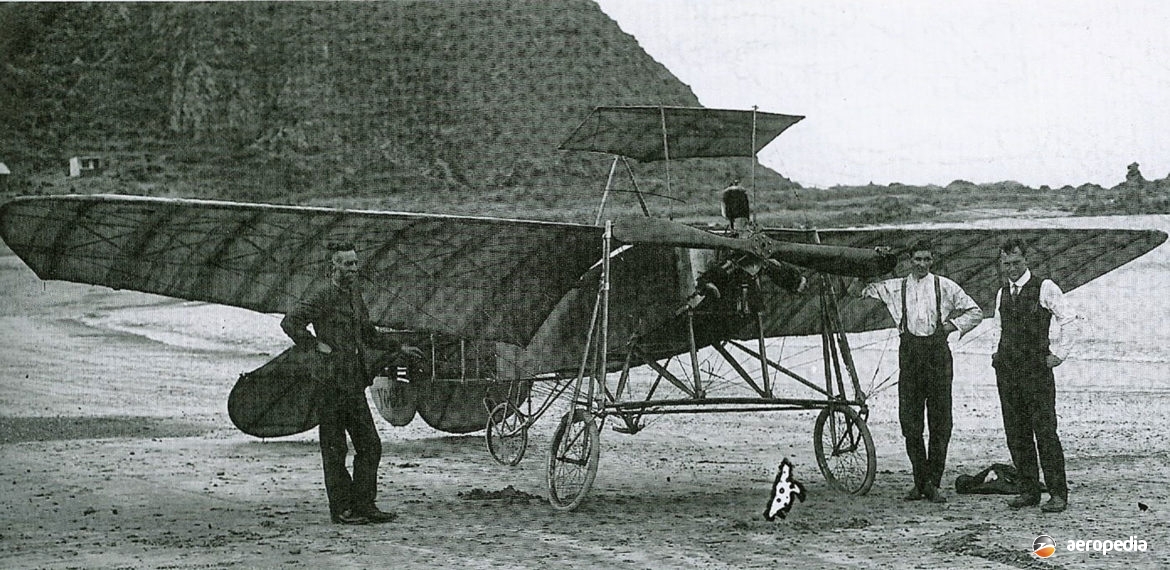Photograph:
Schaef Monoplane at Lyall Bay, Wellington, New Zealand in 1911 (Dominion Museum, Wellington, NZ)
Country of origin:
New Zealand
Description:
Single-seat light aircraft
Power Plant:
[Vogel 2]
One 30 kw (40 hp) eight-cylinder JAP engine
Specifications:
- TBA
History:
Arthur Waldermar Schaef was one of the more successful early aircraft designers and builders who lived in this part of the world in the early 20th Century. He was born at Bendigo, VIC in 1867 and, whilst he was still quite young, his family moved to Greymouth on the west coast of New Zealand where a cabinet making business was set up by his father. He worked with his father for a number of years until he married and moved to Wellington. There he commenced a photography business.
He commenced design of an aeroplane in 1909 using information published in overseas magazines of the time, and by October 1910 he had built an aircraft known as The New Zealand Vogel. Plans and specifications were submitted to the Patent Office and a patent for the design was issued. This aircraft had four spruce longerons joined by steel tubes braced with piano wire, the wooden wings being covered with Japanese silk. Wing warping or ailerons were not used. Underwing elevators were operated by a vertically installed wheel operated by the pilot. A number of propellers were built and tested. A 15 kw (20 hp) four-cylinder JAP engine was installed but on initial testing was found not to provide sufficient power and a 30 kw (40 hp) eight-cylinder JAP engine was fitted.
On completion it was conveyed to the Hutt Park Trotting Course and ground testing commenced on 21 August 1910. The aircraft taxied around the course the following day. Mr Schaef obtained assistance in the early development of the aircraft from another aircraft designer, Percy Fisher, who was a mechanical engineer. This aircraft had a wingspan of 10.66 m (35 ft), a length of 7.92 m (26 ft), a wing area of 31.58 m² (340 sq ft) and a weight of 249 kg (550 lb).
In January 1911 attempts were made by Schaef and his team to fly the machine at Lyall Bay. A successful flight was made on 6 March 1911, witnessed by a number of local residents, including a representative of The Evening Post. The aircraft rose from the beach to a height of 4.5 m (15 ft) and travelled a distance of 47.5 m (156 ft). A further flight was made and, in order to improve performance, another propeller was installed. A further short flight was made but the aeroplane made a heavy landing and sustained some damage.
Schaef then moved on to a second aircraft. A new 26 kw (35 hp) Anzani engine and propeller were obtained from France in 1912 and, with the assistance of Charles Swan, the engine was fitted to the airframe. Described as the Schaef No 2 Vogel, the aircraft had a tricycle undercarriage. This machine had a conventional rudder, tailplane and elevators. The three-cylinder Anzani engine arrived in August 1912 and was installed, the aircraft by this time having been fitted with twin floats.
The Wanganui Herald of 13 November 1912 referred to it as Schaef’s Hydro-Aeroplane, 1913 Model, and reported that it would be placed on exhibition on 14 November. It was displayed at the Hawera A & P Show on 21 and 22 November, and reference was made to unsuccessful attempts to take-off from the Wanganui River. By 4 January 1913 the aircraft had returned to a wheeled undercarriage and was conveyed to Lyall Bay for further testing, these commencing on 4 January 1913. A number of taxiing trials were made along the beach.
Three short hops of about 19 m (60 ft) were made but the machine ended up in the surf. Further testing took place subsequently with floats at Shelly Bay but the propeller was damaged when it hit the water. Later the aircraft was taken to The River Festival at Wanganui where it was placed on display. Attempts were made to fly it from the Wanganui River but do not seem to have been successful.
At one stage in 1914 the Schaef No 2 Vogel was placed on display at a carnival at Newtown Park on which occasion it was placed in a tent and it is assumed an admission fee was charged to the public to see the machine. On 16 March 1914 it was again taken to Lyall Bay where three flights of about 91 m (300 ft) and a height of 6 m (20 ft) were achieved. However, the aircraft was damaged on landing and repairs were commenced in a shed at Lyall Bay. Less than two weeks later, whilst in this shed, both the aircraft and the shed were lost in a fire.
One of the Schaef machines was offered to the Central Flying School at Point Cook, VIC at one stage but was rejected. Percy Fisher was later involved with Reginald White and they achieved some short flights in the Wairarapa district.
Schaef then travelled to the United Kingdom and, whilst there, visited Hendon, making two flights in a Farman. He returned to New Zealand in December 1914 where he continued his photography business but did not build any more aircraft and passed away on 5 June 1940.

